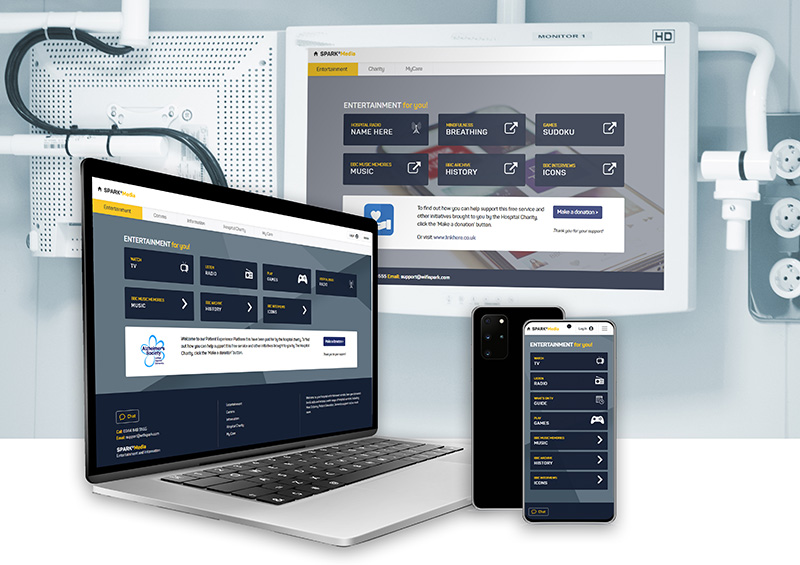Over the past two decades, the NHS has made a big investment in entertainment and communications systems, internet access and WiFi infrastructure.
The first wave came with the installation of bedside terminals that enabled patients to call their loved ones and to watch television without having to wait for a corridor payphone or the ward TV.
And the came with the roll-out of the NHS WiFi programme that enabled patients and visitors to access trust information and internet services on their tablets and phones.
The benefits of the bedside terminals have sometimes been obscured by their ‘patient pays’ business model (which WiFi SPARK is determined to change, now we’ve acquired Hospedia).
But in combination with the WiFi roll-out, they have helped to revolutionise the entertainment, call, chat and internet services that are available to people being treated in hospital. So, what about the people treating them?
Shouldn’t we be using this investment to improve services for staff? I want to argue that we should, and that modern, managed WiFi services, plus creative thinking about those bedside terminals, makes that both possible and affordable.
Why extend patient WiFi to staff?
The case for making entertainment and information available to patients is easy to make; they’re in bed or in a chair most of the day, and they need to understand what’s happening around them.
The case for making connectivity available to staff may seem harder, because if they’re at work, they should be working. However, even in the NHS, people don’t work 24 hours a day. They have rest breaks and lunch breaks.
Also, many staff stay in NHS accommodation, particularly at the start of their careers or when they’re changing jobs. During the pandemic, staff members have even stayed within the grounds due to not spreading possible infections at home, or bringing anything with them into their workplace. At times like that, do they need entertainment? Of course, they do; they’re human beings.
They may also want to catch up with the news, access the trust intranet, look-up information for patients, work through a training module, or use subscription services they have paid for.
Trusts can enable them to do these things by extending their patient WiFi to staff areas and offering them a bundle of managed services (like SPARK Media) to access the apps they want safely and securely.
Technically, there are no significant barriers to doing this. All trusts will have WiFi in patient treatment areas and most will have WiFi in areas like waiting rooms and canteens. If they don’t, we can easily extend coverage to them. If the clinical and the patient WiFi are not connected, we can connect them at low cost.
What about those bedside terminals?
By definition, the NHS’ bedside terminals are in areas where staff are going to be working. So, can we use them to make that work easier?
The idea of using these units to give staff access to electronic patient records has been raised in the past. However, we need to be realistic. The big EPR vendors recommend devices for a reason; they know their systems operate well on them.
It would be a complex and expensive task to integrate an EPR with a WiFi platform, or to reconfigure one to run on a bedside terminal. Instead, the quick wins lie in the many innovations in the health tech market that could be built to work this way from the outset.
A good example is patient check-in. There is a supplier, Intouch with Health, that does patient check-in very well, but it uses kiosks to interface with patients. Imagine if it could use bedside terminals.
Ward staff could check-in patients at the bedside, without having to wait for a computer on wheels, or to walk backwards and forwards to a nursing station, to find details the patient had entered elsewhere.
Another example would be meal ordering. We have a partner, Datasym, that has created an app that integrates with the EPR to obtain basic details about a patient and their nutritional or dietary allowances, so they can be offered appropriate menu choices.
I’d like to see a catalogue of apps like that (and WiFi SPARK is actively working to create one); an app store for health that would make it much easier for innovators to enter the market, for Trusts to take up their ideas, and for staff to be able to click and use their services, right at the bedside.

Why is now the time to do this?
Traditionally, patients have been seen as the most important people in a hospital and as the first recipients for any new services. Yet Covid-19 showed us that the NHS is nothing without its people.
There is huge interest in thanking those people for their efforts during the pandemic, and in finding new ideas for recruiting and retaining staff in an increasingly competitive jobs market, in which work-life balance is valued more than ever before.
The NHS can’t give everybody who works for it a significant pay rise, but Trusts can do small things to show that they care about their staff. If nothing else, they can show they understand that NHS staff deserve the kind of internet and smartphone connectivity that is taken for granted in many other workplaces.
Extending the patient WiFi amenity to staff is a good way to do that. The IT department might need to do a little bit of configuration or buy some equipment to secure the necessary coverage, but after that it can work with a WiFi provider to offer an attractive and affordable bundle of services.
In the context of a hospital budget, we’re going to be talking about a small share of wallet for a big gain; staff good-will, better access to apps that can reduce administration and improve patient care and, finally, a return on the very significant investment in entertainment and communications infrastructure that the NHS has already made.
